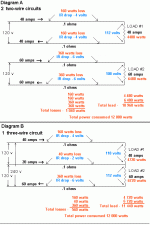Flicker Index
Senior Member
- Location
- Pac NW
- Occupation
- Lights
It's dangerous. If they're two separate breakers, it would be assumed that if breaker for pump 1 is turned off, the neutral associated with pump 1 can be lifted when in reality, it would be live with pump 2 in series. If it was handle tied, independent trip, you can not turn one breaker off without turning both off.Those breakers will operate completely separately. If one trips the other won't, unless some common fault actually hitting both circuits occurs.
This may be a code violation. This may be permissible in your locality, and was permitted in prior versions of the code. But current code requires requires breakers that are tied together so that if you are working on one half of the circuit you don't get shocked by the neutral. It isn't a problem unless someone is working on the circuits, so as long as you are not doing any DIY work it isn't a safety issue.
-Jonathan


